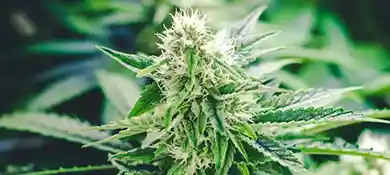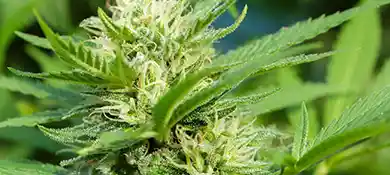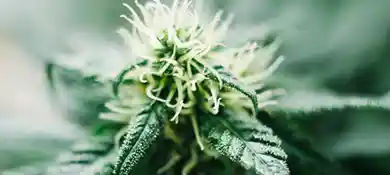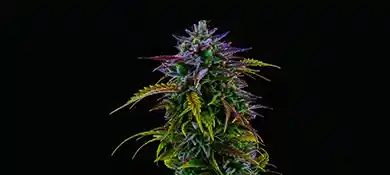Understanding Bud Rot in Cannabis: Prevention and Control of Botrytis
Bud rot is a formidable threat to cannabis growers. This insidious disease can devastate entire crops in a matter of days, turning lush, vibrant buds into mushy, grayish masses.
What is Bud Rot?
Bud rot is a fungal infection that targets the buds of cannabis plants, causing them to decay and become unusable.

Definition of Bud Rot
Bud rot, also known as "botrytis bud rot" or "grey mold," is a fungal disease primarily caused by Botrytis cinerea. It is also the most common humidity-related disease of the cannabis plant.
Unlike other types of mold that may appear on the leaves or stems of the cannabis plant, bud rot specifically targets the plant's dense flowers. The rot of these buds can make them worthless, so bud rot is the nightmare of all cannabis growers.
The Biology of Bud Rot: Fungal Species Behind the Disease
Bud rot in cannabis is primarily caused by the fungus Botrytis cinerea, but other species within the Botrytis genus have also been identified as contributors. Botrytis cinerea is the most aggressive species responsible for the disease, thriving in humid, cool environments commonly found in indoor grow rooms. The fungus infects cannabis buds, usually starting at the base, where moisture accumulates. This leads to the rapid spread of decay, turning the buds brown or grey and rendering them unusable.
Another species, Botrytis pseudocinerea, has also been found in cannabis plants. While it is less aggressive than Botrytis cinerea, it can still cause bud rot under high humidity conditions. However, it spreads more slowly and is generally less destructive. Despite its lower pathogenicity, Botrytis pseudocinerea can weaken the plant and reduce overall crop quality.
A third species, Botrytis porri, has been isolated from cannabis, though its role in bud rot is less significant. It is typically a secondary infection, appearing only after the plant has already been weakened by other fungi like Botrytis cinerea. This species is not as aggressive and does not lead to rapid rot, but it can still contribute to further decay if the plant is already compromised.
While Botrytis cinerea remains the primary cause of bud rot, the presence of Botrytis pseudocinerea and Botrytis porri highlights the variety of fungi that can contribute to the disease. Understanding these species and their behaviors is key to preventing and managing bud rot in cannabis cultivation.

The Life Cycle of Bud Rot
Bud rot, a common and destructive fungal disease affecting cannabis crops, progresses through a well-defined life cycle.
- 1. Spore Production: The fungus responsible for bud rot produces infectious spores known as conidia. These tiny reproductive units are the primary agents that spread the disease among cannabis plants.
- 2. Germination: When conidia encounter a suitable cannabis host, they germinate under the right environmental conditions, including high humidity and poor airflow. This stage allows the spores to penetrate the plant's outer tissue, initiating infection.
- 3. Colonization: Once inside the cannabis plant, the fungus begins to grow and spread throughout the tissues. This process weakens the plant, making it susceptible to further damage as the infection progresses.
- 4. Symptom Development: Symptoms of bud rot typically manifest as gray or brown mold on the leaves, stems, or buds. Over time, these visible signs spread to the flowers and fruits, rendering the affected parts unusable and reducing the overall yield.
- 5. Spore Dispersal: As the infected plant material decays, the fungus generates additional conidia, which can infect nearby plants. This dispersal mechanism enables the disease to spread rapidly in grow rooms or greenhouses where conditions favor fungal growth.
- 6. Overwintering: In certain cases, bud rot fungi can overwinter in plant debris or soil. This persistence allows the disease to survive between growing seasons and reemerge to infect new crops.
By interrupting the life cycle at critical points, cannabis growers can significantly reduce the risk of bud rot outbreaks and protect their crops.
Why Bud Rot is a Cannabis Grower’s Worst Nightmare
Bud rot is the worst nightmare of cannabis growers, and for good reason. This devastating disease not only threatens the health of the plant but also causes significant financial losses for growers. Bud rot on cannabis plants, often caused by Botrytis cinerea, is particularly insidious because it attacks the most valuable part of the plant—the cannabis flower. Once the infection sets in, it can quickly spread, destroying large portions of the crops.
Increased Vulnerability
Once bud rot takes hold, the plant becomes more susceptible to other diseases and environmental stressors. The decay caused by fungi weakens the cannabis tissues, making it easier for additional pathogens to invade. This increased vulnerability often leads to a cycle where multiple infections compound the damage, accelerating the decline of the crop. Moreover, plants that have already been infected with bud rot may struggle to recover, as the fungal pathogen impacts not only the buds but also the plant’s overall vitality, weakening the entire structure of the cannabis plant.
Quality Degradation
One of the most immediate and apparent consequences of bud rot is the degradation of cannabis quality. Bud rot affects the very part of the plant that growers value the most—the buds. As the fungus infiltrates the dense flower clusters, it causes the cannabis flower to decay, turning them brown, grey, or even black—hallmarks of gray mold. This moldy cannabis appearance is not just unappealing to the eye but also compromises the plant's potency and aroma. Cannabis production that has been infected with bud rot often loses its desired effects and fragrance, rendering it unsuitable for sale or consumption. Even a small amount of bud rot can spread quickly, infecting neighboring buds and rapidly diminishing the entire crop's overall quality.
Economic Losses
Bud rot is one of the major sources of economic loss for cannabis growers. Infected buds must be discarded, resulting in lower yields and wasted resources. Since the primary value of cannabis is in its flowers, any damage to the buds translates directly to lost profits. For commercial growers, the financial impact can be significant, especially in large-scale operations where the spread of bud rot can quickly devastate entire batches. Even small infections, if not caught early, can scale up and lead to severe crop damage, further impacting the grower's bottom line.
Symptoms of Bud Rot: How It Progresses at Different Growth Stages
Bud rot is a progressive disease that evolves in distinct stages as cannabis cultivation progresses. If not controlled at an early stage, it can cause serious damage.
Early Signs During Vegetative Stage
Bud rot is rare during the early growth stages, but can still occur under adverse conditions. High humidity, inadequate airflow, and overwatering can make plants more susceptible to fungal infections. Staphylococcus griseus infections may occur in propagation chambers during this stage of plant growth if relative humidity (RH) is high, resulting in sudden onset disease or leaf necrosis.

Flowering Stage: Advanced Symptoms and Spread
As the cannabis plant redirects its energy towards flowering, dense buds form at the top of the plant. The plant will continue to evaporate moisture during growth, and if humidity is not effectively controlled, water vapor will accumulate in the air, causing the relative humidity to rise. Coupled with insufficient ventilation in the growing room, this creates a microclimate near the dense cannabis buds, which quickly becomes a hotbed for bud rot infections caused by Botrytis cinerea.
The first sign of bud rot is often seen as a small area of discolored, mushy tissue within the bud. The affected area may appear brown, grey, or black, and the tissue often feels soft and decayed. Infected buds start to break down from the inside, causing the flowers to collapse and emit a musty, unpleasant odor, which is characteristic of the disease. Spores from the fungal pathogen spread quickly within the dense flower clusters, leading to rapid contamination of surrounding buds.

Late Flowering and Harvest: Hidden Dangers and Losses
As plants approach harvest, bud rot can be especially deceptive. While the buds may look perfect on the outside, the internal tissue may already be rotting, making detection difficult. The disease causes the buds to soften and deteriorate from within, often going unnoticed until after harvest. By then, the damage is usually extensive. Infected buds can also spread the rot to other parts of the crop during drying or curing. If not controlled, bud rot continues to affect the product postharvest, leading to further quality loss. For growers, this can result in significant financial losses, especially with susceptible strains, where up to 30% of the yield may be lost.

Differences in Susceptibility to Bud Rot Among Cannabis Genotypes
Bud rot doesn’t affect all cannabis plants the same way. While its progression follows a predictable path across growth stages, not every plant is equally at risk. Much of this variation comes down to genetics. Certain strains seem more vulnerable, while others fare better under the same conditions.
Comparative Infection Rates Among Genotypes
The study of three cannabis genotypes—Jet Fuel Gelato, Pink Kush, and Black Cherry Punch—reveals significant differences in their susceptibility to bud rot when grown under identical greenhouse conditions. As shown in the data collected from August to October, Jet Fuel Gelato demonstrated the highest vulnerability, with bud rot rates increasing sharply to around 25% by October. Pink Kush also showed moderate susceptibility, with infection rates reaching 15%. In contrast, Black Cherry Punch maintained exceptional resistance, with rates consistently under 5% throughout the observation period.
The Influence of Bud Structure in Susceptibility
These findings suggest that bud structure and density are key factors influencing susceptibility. Jet Fuel Gelato, with its dense and large buds, creates an environment that retains moisture, fostering the development of moldy cannabis. Pink Kush, while less dense, still possesses moderately compact structures, explaining its intermediate infection rates. On the other hand, Black Cherry Punch’s smaller and looser buds allowed for better airflow and reduced moisture retention, significantly lowering its risk of infection.

Factors Influencing Bud Rot on Cannabis
The development of bud rot caused by the fungal pathogen Botrytis cinerea depends on a number of environmental factors that together create favorable conditions for infection. These environmental factors are also the ones that growers need to pay close attention to in their daily cannabis cultivation processes.
Relative Humidity
High relative humidity is one of the main causes of bud rot. When humidity levels remain high for a long period of time, the moisture in the air can adhere to the dense cannabis buds, causing the inner layers of the buds to accumulate water that cannot evaporate. This creates a humid microenvironment that provides favorable conditions for the growth of fungal pathogens like Botrytis cinerea.
Temperature
Studies have shown that the mycelial growth of the Aspergillus niger isolate in vitro is fastest at 15–25°C. The optimum temperature for cannabis production during the growth phase is usually maintained at around 20–30°C, which provides suitable temperature conditions for the reproduction and spread of Aspergillus niger.
Airflow
Inadequate airflow creates stagnant pockets of moist, humid air around cannabis buds, especially in dense grow rooms. This trapped moisture provides an ideal environment for Botrytis cinerea spores to settle and germinate. Without proper air movement to dry wet surfaces, condensation persists, allowing the fungus to penetrate plant tissues and spread rapidly. Growers can create conditions that are less favorable for Botrytis cinerea by understanding and controlling these environmental factors.
Bud rot doesn’t arise from just one environmental factor—it results from a combination of high humidity, conducive temperatures, and insufficient airflow. Together, these conditions create a perfect environment for fungal spores to germinate and infect cannabis plants. By simultaneously addressing these factors, growers can create an inhospitable environment for Botrytis cinerea, minimizing the risk of infection and ensuring healthier, more productive crops.

Preventive Measures for Cannabis Bud Rot
Treating bud rot caused by Botrytis cinerea after it has developed is nearly impossible and impractical for large-scale cultivation. The best approach to prevent an outbreak is to stop its progression rather than trying to treat infected plants.
Humidity Control
Excess humidity creates ideal conditions for bud rot by encouraging moisture buildup on cannabis buds, especially in dense flowering plants. To tackle this, many growers rely on dehumidifiers to remove excess moisture from the air. While this approach works, traditional dehumidifiers paired with standalone air conditioning systems often lead to inefficiencies.
Temperature Control
Although high humidity is the main factor leading to cannabis bud rot, fluctuations in temperature can also affect relative humidity. Therefore, while humidity management is important, temperature management should not be overlooked.
Improving Air Circulation
Insufficient airflow is another major contributor to bud rot, as stagnant air allows moisture to settle on cannabis buds, especially in areas with dense foliage. Many growers use oscillating fans to improve air circulation and prune overcrowded sections of their plants to ensure better airflow.
While these methods are helpful, they may not be sufficient in larger grow rooms or high-density setups, leaving certain areas at risk of moisture buildup. Altaqua Grow Room HVAC System provides a more modern and ideal temperature and humidity control solution.
Traditional dehumidifiers rely on relative humidity (RH) to manage moisture, but RH is highly sensitive to temperature changes. In grow rooms, frequent temperature fluctuations caused by grow lights or ventilation systems can lead to unstable RH readings, making it difficult to maintain consistent moisture levels. These variations create conditions that can foster mold on cannabis.
Altaqua Grow Room HVAC Systems overcome this challenge by using dew point control instead of relative humidity. Unlike RH, dew point is independent of temperature, providing a more accurate and consistent measure of moisture in the air. By integrating temperature and humidity control into a single system, Altaqua ensures that growers achieve precise moisture management without the inaccuracies caused by temperature fluctuations. This stable control helps prevent bud rot and supports the overall health of cannabis plants.
While traditional systems like oscillating or exhaust fans can help circulate air, they often fail to provide uniform coverage throughout the grow room, leaving certain areas vulnerable to mold development.
Altaqua Grow Room HVAC System uses efficient EC fans that adjust dynamically based on real-time environmental data, ensuring even air distribution across the grow room. This eliminates stagnant pockets of air and reduces the risk of moisture settling on cannabis buds. Additionally, optional fresh air ventilation features can be integrated to enhance airflow further, ensuring an optimal environment for cannabis cultivation.

Comparing Bud Rot Severity in Controlled vs. Uncontrolled Grow Rooms
Bud rot severity differs drastically between controlled and uncontrolled grow environments. Research shows that greenhouses without adequate climate control face infection rates of up to 50%, driven by high humidity (above 60%) and poor airflow (Punja and Ni, 2021). These conditions allow Botrytis cinerea to thrive, especially during peak growing seasons.
In contrast, controlled grow rooms significantly reduce bud rot cases, with advanced systems lowering infection rates to as little as 2%-5% (Jin et al., 2021). The significant difference in bud rot severity between the controlled and uncontrolled grow rooms highlights the importance of advanced climate control. Uncontrolled environments often face devastating outbreaks of mold on the weed, while grow room HVAC can provide growers with a controlled growing environment to protect the cannabis buds.
Conclusion
Bud rot is a persistent and destructive challenge for cannabis growers, affecting both the health of plants and the profitability of operations. This fungal disease, primarily caused by Botrytis cinerea, thrives in environments with high humidity, unstable temperatures, and poor airflow. Left unchecked, it can progress stealthily through various growth stages, causing significant losses by degrading the quality of cannabis buds and reducing yields.
Prevention remains the most effective strategy, as treating bud rot after infection is both impractical and costly. Ultimately, investing in robust preventive measures and maintaining a controlled growing environment are essential to protecting cannabis buds from the devastating effects of bud rot. By staying vigilant and adopting advanced solutions, growers can ensure healthier plants, better yields, and a more sustainable operation.
FAQ
1. What is bud rot, and how does it impact cannabis plants?
Bud rot, or Botrytis cinerea, is a fungal disease that damages cannabis buds by causing them to decay from the inside. It thrives in humid and poorly ventilated environments, often going unnoticed until significant damage has occurred. Bud rot spreads quickly, reducing yield and quality, making early prevention and strict environmental control essential for protecting plants.
2. What are the early symptoms of bud rot in cannabis?
Early symptoms of bud rot include discolored leaves near the buds, often yellow or brown, along with a soft, mushy texture inside the buds. Over time, gray or white fungal spores may appear, signaling the spread of the infection.
3. Why does bud rot spread faster in uncontrolled environments?
Uncontrolled grow rooms often have excessive humidity, unstable temperatures, and poor air circulation—perfect conditions for Botrytis cinerea. Studies show that greenhouses with poor ventilation can experience infection rates as high as 50%. Controlled environments, with optimized airflow and climate regulation, greatly reduce the chances of outbreaks.
4. How does bud rot differ from other cannabis mold issues?
Bud rot specifically refers to Botrytis cinerea, which targets cannabis buds and causes internal decay. Other molds, such as powdery mildew, appear on leaves or stems and are more visible. Both issues require careful humidity and airflow management, but bud rot is harder to detect and more destructive if left unchecked.
5. Can infected cannabis buds be salvaged after bud rot?
Cannabis buds infected with bud rot cannot be saved or safely consumed, as the fungus produces harmful toxins. Infected material must be removed and destroyed immediately to protect healthy plants. The best strategy is prevention by maintaining strict control over humidity, temperature, and airflow.
Share with your friends:
Popular Blogs on Altaqua:
Download Catalogue





